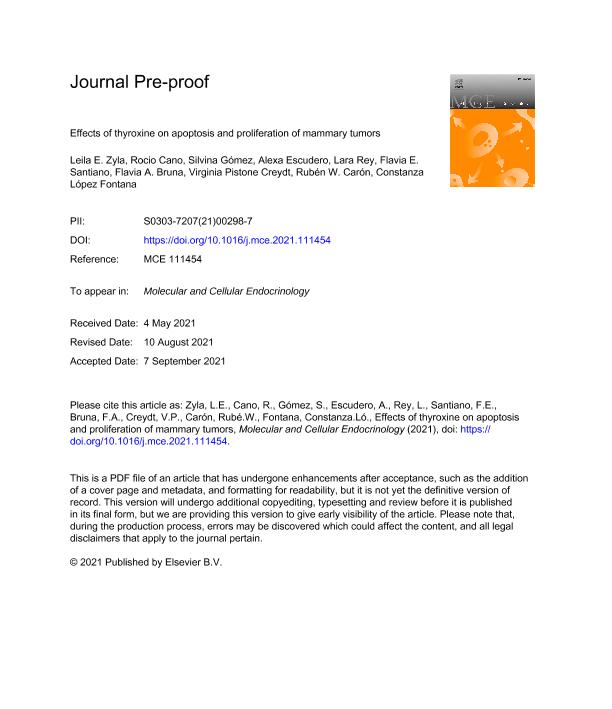Artículo
Effects of thyroxine on apoptosis and proliferation of mammary tumors
Zyla, Leila Ester ; Cano, Rocio Yasmin
; Cano, Rocio Yasmin ; Gomez, Silvina Esther
; Gomez, Silvina Esther ; Escudero, Alexa; Rey Echalecu, Lara Sofía
; Escudero, Alexa; Rey Echalecu, Lara Sofía ; Santiano, Flavia Eliana
; Santiano, Flavia Eliana ; Bruna, Flavia Alejandra
; Bruna, Flavia Alejandra ; Pistone Creydt, Virginia
; Pistone Creydt, Virginia ; Caron, Ruben Walter
; Caron, Ruben Walter ; López Fontana, Constanza Matilde
; López Fontana, Constanza Matilde
 ; Cano, Rocio Yasmin
; Cano, Rocio Yasmin ; Gomez, Silvina Esther
; Gomez, Silvina Esther ; Escudero, Alexa; Rey Echalecu, Lara Sofía
; Escudero, Alexa; Rey Echalecu, Lara Sofía ; Santiano, Flavia Eliana
; Santiano, Flavia Eliana ; Bruna, Flavia Alejandra
; Bruna, Flavia Alejandra ; Pistone Creydt, Virginia
; Pistone Creydt, Virginia ; Caron, Ruben Walter
; Caron, Ruben Walter ; López Fontana, Constanza Matilde
; López Fontana, Constanza Matilde
Fecha de publicación:
12/2021
Editorial:
Elsevier
Revista:
Molecular and Cellular Endocrinology
ISSN:
0303-7207
Idioma:
Inglés
Tipo de recurso:
Artículo publicado
Clasificación temática:
Resumen
Hypothyroidism is a protective factor against breast cancer but long-term exposure or overdoses of thyroid replacement therapy with thyroxine (T4) may increase breast cancer risk. Objective: to study, in vivo and in vitro, the effects of T4 on the proliferation and apoptosis of mammary tumors of hypo- and euthyroid rats, and the possible mechanisms involved in these effects. Material and Methods: Female Sprague-Dawley rats were treated with a single dose of dimethylbenzathracene (15 mg/rat) at 55 days of age and were divided into three groups: hypothyroidism (HypoT; 0.01% 6-N-propyl-2-thiouracil -PTU- in drinking water, n = 20), hypothyroidism treated with T4 (HypoT + T4; 0.01% PTU in drinking water and 0.25 mg/kg/day T4 via sc; n = 20) and EUT (untreated control, n = 20). At sacrifice, tumor explants from HypoT and EUT rats were obtained and treated either with 10−10 M T4 in DMEM/F12 without phenol red with 1% Charcoalized Fetal Bovine Serum or DMEM/F12 only for 15 min to evaluate intracellular signaling pathways associated with T4, and 24 h to evaluate changes in the expression of hormone receptors and proteins related to apoptosis and proliferation by immunohistochemistry and Western Blot. Results: In vivo, hypothyroidism retards mammary carcinogenesis but its treatment with T4 reverted the protective effects. In vitro, the proliferative and anti-apoptosis mechanisms of T4 were different regarding the thyroid status. In EUT tumors, the main signaling pathway involved was the cross-talk with other receptors, such as ERα, PgR, and HER2. In HypoT tumors, the non-genomic signaling pathway of T4 was the chief mechanism involved since αvβ3 integrin, HER2, β-catenin and, downstream, PI3K/AKT and ERK signaling pathways were activated. Conclusion: T4 can regulate mammary carcinogenesis by mainly activating its non-genomic signaling pathway and by interacting with other hormone or growth factor pathways endorsing that overdoses of thyroid replacement therapy with T4 can increase the risk of breast cancer.
Palabras clave:
BREAST CANCER
,
HER2
,
THYROXINE
,
TRΒ1
,
ΑVΒ3 INTEGRIN
,
Β-CATENIN
Archivos asociados
Licencia
Identificadores
Colecciones
Articulos(IMBECU)
Articulos de INST. DE MEDICINA Y BIO. EXP. DE CUYO
Articulos de INST. DE MEDICINA Y BIO. EXP. DE CUYO
Citación
Zyla, Leila Ester; Cano, Rocio Yasmin; Gomez, Silvina Esther; Escudero, Alexa; Rey Echalecu, Lara Sofía; et al.; Effects of thyroxine on apoptosis and proliferation of mammary tumors; Elsevier; Molecular and Cellular Endocrinology; 538; 12-2021; 1-37
Compartir
Altmétricas



